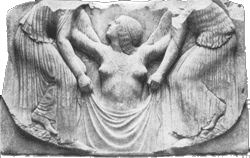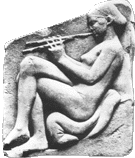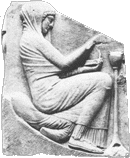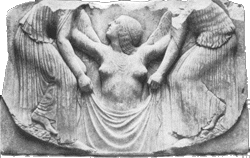
My historical novel, DAUGHTERS OF TIME, traces a line of mothers and daughters through 4000 years as they carry the way of the Goddess from ancient Sumer to the present day. In 1926, a daughter in the lineage is born in Southern Italy:
“Maria’s family had lived in the village and surrounding area for longer than anyone could remember. Like all the girls of her village, she grew up a Catholic, yet on Christmas Eve she gathered with the other women to perform a ritual in the Church that no man was allowed to see. The words she spoke would have been familiar to her many, many times great grandmother, Meh-tan, who once met a Queen in Ursalimmu.It did not occur to Maria that the ritual was not in keeping with the teachings of the Church; it was what her mother and all the mothers before her had done on Christmas Eve to honour the Great Mother.“
Five years after writing about my fictional Maria, I stood in the church in Calabria where my grandmother Carmella once met with the other women on Christmas Eve. And the Great Mother was still there – the Madonna del Carmine a Varapodio, whom the people call “O Madre nostra cara.”

The transition from Goddess to Madonna is very tangible in Calabria . . .
Forty kilometres from my grandmother’s town, on the Ionian coast, lie the ruins of Locri Epizephyrii, one of the most important cities of Magna Graecia. Excavations have revealed a temple of Aphrodite, a sanctuary of Persephone, and numerous terracotta plaques and votive offerings. The famous marble sculpture known as the Ludovisi Throne is understood to have come from the temple of Aphrodite (Temple of contrada Marasa) at Locri.

The measurements of the sculpture fit perfectly with three great stones still standing at the site:

A book called The Locrian Maidens proposes that the abundance of female dominated iconography and mythology found at Locri suggests “… a distinct, perhaps even deliberate ‘third way’ in contrast to the systems of classical Athens and Sparta.”[i] At the heart of this difference was a unique approach to the mythology and rites usually associated with Demeter/Persephone.
 At the core of this difference was a joining together of two Goddesses usually seen as opposites: Persephone and Aphrodite. In most of the temples of Magna Graecia, Persephone was represented as daughter of Demeter and Queen of the Underworld. In this capacity, Persephone presided over the domain of legitimate marriage and child rearing, while Aphrodite was more explicitly erotic, presiding over love affairs outside marriage. The two Goddesses were often represented as opposites: at around the same time as the temples were being built at Locri, Hesiod’s poetry depicted Persephone and Aphrodite as rivals, fighting over a man (Adonis).
At the core of this difference was a joining together of two Goddesses usually seen as opposites: Persephone and Aphrodite. In most of the temples of Magna Graecia, Persephone was represented as daughter of Demeter and Queen of the Underworld. In this capacity, Persephone presided over the domain of legitimate marriage and child rearing, while Aphrodite was more explicitly erotic, presiding over love affairs outside marriage. The two Goddesses were often represented as opposites: at around the same time as the temples were being built at Locri, Hesiod’s poetry depicted Persephone and Aphrodite as rivals, fighting over a man (Adonis).
 In many of the Locri images of ritual activities, the symbolism of Aphrodite and Persephone were represented together: the plaque opposite shows a girl offering a ball and a rooster to a goddess, “while a goose flexes its wings beneath the offering table.”[ii] Roosters were considered chthonic birds, linked to Persephone. Geese were usually linked to Aphrodite. Here the identity of the goddess is ambiguous – Persephone or Aphrodite? Or Persephone/Aphrodite?
In many of the Locri images of ritual activities, the symbolism of Aphrodite and Persephone were represented together: the plaque opposite shows a girl offering a ball and a rooster to a goddess, “while a goose flexes its wings beneath the offering table.”[ii] Roosters were considered chthonic birds, linked to Persephone. Geese were usually linked to Aphrodite. Here the identity of the goddess is ambiguous – Persephone or Aphrodite? Or Persephone/Aphrodite?
This integration of Persephone and Aphrodite – unique to Locri Epizephrii – suggests an emphasis on initiatory rituals, rites of passage exploring the intersection of death, sex and transformation. The transformation of the Kore to Queen of the Underworld was always a part of the story underlying the Thesmophoria rituals, yet the emphasis was usually on the Demeter/Persephone cycle of loss and renewal: Persephone’s descent = Demeter’s mourning and the barrenness of Winter; Persephone’s return = Demeter’s rejoicing and the renewed fertility of Spring. In Locri Epizephyrii there appears to have been at least equal importance placed on Persephone’s initiation as she crossed from Kore (maiden) to Queen (mature woman).
The ritual sites at Locri suggest that combined worship of Persephone and Aphrodite provided a pathway for maturation from girl to woman, wife, mother, and perhaps hetaira. Consistent with this, there seems to have been an “absence of discrimination against the prostitute.”[iii] The sides of the Ludovisi Throne show two female figures worshipping the goddess: “on the left side, a naked hetaira plays an aulos,” and in the right, “a heavily draped matron burns incense.”[iv]


It is not surprising that scholars have disagreed about the identity of the figure arising in the main panel of the Ludovisi Throne: Aphrodite arising from the waves, or Persephone arising from the Underworld?
Perhaps She is both together.

Or perhaps the image shows the initiate transformed, rising between Aphrodite and Persephone, guided and supported by both …
What if the pathway from Kore to Queen, from Maiden to mature Sovereignty involved walking with Persephone and Aphrodite together, making the crossing with their joint blessings? What might come from such an initiation?
I think we might find less rivalry between women, fewer women stuck in over-idealised youthfulness, and more experience of empowerment, choice, and control in women’s relationships with self, others, and the World . . .
Blessed Be!
[i] J. M. Redfield, 2003. The Locrian Maidens. Love and Death in Greek Italy. Princeton and Oxford: Princeton University Press.
[ii] M. B. Skinner. “Nossis and Women’s Cult at Locri.” www.stoa.org/diotima/essays/fc04/Skinner.html. URL accessed 3/9/14
[iii] Ibid.
[iv] Ibid.
Dr. Kaalii Cargill is a ‘physician of the soul’, living and working in Melbourne, Australia. In the 1980s she co-developed Soul Centred Psychotherapy, a therapeutic modality based on a profound respect for the feminine principle. www.kairoscentre.com. Kaalii’s engagement with ritual has spanned 25 years and includes participating in regular women’s circles and seasonal rituals, teaching therapeutic ritual, running initiation rituals, and sponsoring the development of ongoing ‘Moon groups’. Her work draws from the ancient mystery traditions of Sumer, Greece, and Egypt as well as the Reclaiming tradition. Kaalii writes fiction and non-fiction that asks, “What if . . .?” The themes of her writing emerge from the Goddess movement and political activism, with a focus on dismantling and resisting structures of power and domination and actively honouring and defending the Earth and the feminine principle. Her short stories have been published in international magazines, and she has 5 books available on Amazon. http://kaalii.wix.com/soulstory
Discover more from Feminism and Religion
Subscribe to get the latest posts sent to your email.


Beautiful article! Thank you for this.
I remember visiting the site of ancient Syracuse in Sicily. There’s a Greek temple to Athena that literally forms the foundation of a church dedicated to Maria Stella Maris. If you go inside the church, you can still see the ancient temple pillars. Outside the ancient temple, a gilded statue of Athena once faced the sea, but now a statue of Mary, Star of the Sea, stands in the same place.
LikeLike
I am looking forward to visitng the ancient temple sites in Sicily next year. I did visit Lipari, and statues of the Goddess abound in the museum there.
LikeLike
The island of Malta has Goddess sites going back into prehistory. Today, the cult of the Great Mother (the Madonna) is as vital as it ever was. Attend the festa (feast) of the Immaculate Conception in December, and after hearing the young men improvise praise poems to their beloved Mother as her silver-gilt statue is carried through the streets, go back and read Hesiod on the worship of Isis.
All honour to you, beloved and most powerful mother. Bless your daughters and their children.
LikeLike
I’m planning to visit the Goddess sites on Malta next year as well. What a beautiful descritpion of the festa!
LikeLike
Fascinating and interestingly illustrated, thanks Kaalii. Lots to think about and discuss.
Connecting Persephone (our courage to descend into our deepest consciousness and awareness) with Aphrodite, as representative of the explicit expression of our passionate and erotic potential, is magnificently suggested also by Audre Lorde in her essay, “Uses of the Erotic: The Erotic as Power,” where she says:
“The erotic is a resource within each of us that lies in a deeply female and spiritual plane, firmly rooted in the power of our unexpressed or unrecognized feeling. In order to perpetuate itself, every oppression must corrupt or distort those various sources of power within the culture of the oppressed that can provide energy for change. For women this has meant a suppression of the erotic.”
The ancient Greek Hymn to Demeter and Persephone, acts as a sort of liminal counselor which enables us to enter into the dark of the subconscious and return with the light of wisdom our journey provides. The name “Persephone” is really all about enlightenment, it means literally “Great Wisdom” (Per=great + Sophos=wisdom). In Zen Buddhism, Persephone would be worshiped as a Bodhisattva motivated by profound compassion, very similar to Kuan Yin, who also journeys to the underworld and returns.
LikeLike
Like Sarah (above), I’m fascinated with anything that has to do with Demeter/Persephone. I LOVE the idea of Persephone and Aphrodite as aligned or even as one goddess. I just returned from a tantra meditation workshop (doesn’t that sound like an oxymoron to some of you?) where we learned to savor our vibrancy through the use of our senses and our sensual nature. We reached our spiritual depths by using the sense(s) that brought us in tune with ourselves. This is the same linkage of the sensual spirit that you posit in the Persephone/Aphrodite connection.
My one problem with your description is your statement that Persephone was associated with “legitimate marriage and childbearing.” How can this be (or how did this occur historically) when Persephone herself was the victim of bride theft? Hades abducted her, raped her, and in this way made her his wife. In my understanding of the Homeric Myth to Demeter, this is one of the reasons that Demeter rages against the gods for the return of her daughter.
LikeLike
Yes, an important question! Perhaps this link between Persephone and “legitimate marriage” points to the emphasis on the initiatory aspect of the ritual: the transition from Kore to Queen of the Underworld. Of course we are troubled by the abduction and rape of Persephone! But maybe that’s the point of it; i.e Is it a symbolic description of what it’s like to encounter the cthonic Underworld in a way that results in generative transformation? The Goddess in my experience is not just a loving Mother who nurtures me; She can also be fierce, rageful and shocking. How do we come to know Her in all her aspects?
The huge difficulty in the Persephone story is translating the abduction and rape into symbolic/ritual terms, as the terrible, unacceptable, shocking abuse of women makes any reference to rape so abhorrent.
When Inanna descended to meet Ereshkigal she was naked and bowed low, and then she was killed and her corpse hung on a hook to rot. Not acceptable in any way that a woman be treated like that! Yet what is the story telling us about transformative, initiatory ritual? That it is like being stripped naked, killed, and hung on a hook? That it is like being adbducted and raped?
Perhaps the horror in these stories is a device to ensure that the transformative, visceral impact is not diluted by making them “nothing but” stories. Perhaps our normal culturally conditioned consciousness has to be shocked, horrified, and “hung on a “hook” for 3 days for deep transformation to happen . . .
The whole cycle for both Inanna and Persephone follows the ritual form of relinquishing, crossing, and returning. Perhaps the relinquishing cannot always be voluntary – I certainly have had the experience of Life “stripping” me and hanging me on a hook!
It’s so important that we continue to be curious about what these stories have to offer . . .
LikeLike
Kaalii —
I agree with you that the goddess “is not just a loving Mother who nurtures me; She can also be fierce, rageful and shocking.” If you doubt this statement, please read my post on Kali (Part 1 –https://feminismandreligion.com/2014/08/30/kali-ma-the-dark-creator-and-destroyer-by-nancy-vedder-shults and part 2 — https://feminismandreligion.com/2014/09/21/ramakrishna-devotion-to-kali-ma-part-2-of-3-by-nancy-vedder-shults/. The 3rd part is coming out in 10 days).
But saying that rape is “a symbolic description of what it’s like to encounter the cthonic Underworld” or that rape symbolizes the initiatory rites that shock us out of our culturally conditioned consciousness doesn’t satisfy me with respect to the Demeter/Persephone myth. I can see that with respect to the Inanna myth. Death occurs in the Underworld. But normalizing bride theft as “legitimate marriage” tells me that this myth is about more than just the transformative qualities of the Underworld. It’s about a huge historical change in male/female relations, about a patriarchal culture that has come into the Greek archipeligo and overthrown an indigenous society and traumatized its women. As a rape survivor, I an only see the Demeter/Persephone myth in these terms.
LikeLike
I agree with Nancy. I think it is important to recognize that just because something is in a myth that does not make it true. We learned this about the Bible. Greek and Sumerian myths come from patriarchal cultures. If they contain grains of truth for us, they also contain elements that normalize and legitimize patriarchy and the domination of women. Just because it is myth–even Goddess myth– it does not necessarily contain archetypal truth for women today.
LikeLike
I agree that just because something is in a myth that does not make it true. I am reaching for a more complex understanding when I write about the shock of encountering the chthonic Underworld forces in initiatory ritual.
The abuses of the patriarchy and the personal trauma many of us have experienced probably make it impossible to ever consider rape as representing anything but horrendous abuse – and rightly so. But I don’t think Persephone’s abduction and rape was ever meant to be taken literally.
I agree that a rape story does seem to suggest bride theft and to represent a patriarchal culture that traumatises its women, yet the Thesmophoria was one of the great mystery traditions honouring the Goddess and the rhythms and cycles of Nature. I am still curious . . .
LikeLike
Another question we might address is whether the Hymn to Demeter, the actual Greek text which has come down to us, is intended as a document of protest? I believe it is, whereas most or all mythological texts from the Greeks and Romans have no such underpinning. There is strong evidence that the Hymn as we have it was written by Sappho. It is dated to her time, her meter, her dialect, her vocabulary, and reflect her brilliance as a poet. Yes, the general idea of the myth was passed down from far more ancient times, but the actual poem that we have takes on all sorts of nuances that reflect the sensibilities of the poet who transformed it into her own version. There is an interesting scene in the Underworld, for instance, where Persephone continues to refuse the sexual advances of Hades, that is, she refuses to be his wife. (L-342-343). They have no offspring either in Greek mythology. Persephone’s protest is why she only has to spend winter in his domain, and is then allowed by Zeus to return to her mother, so she achieves a good measure of liberation through her refusal to cooperate.
LikeLike
Sarah – interesting to consider the Hymn as a document of protest. What do you make of the story of Persephone deliberately eating a pomegranate seed so she could spend time in the Underworld? And the pinake showing her alongside Hades as Queen of the Underworld?
LikeLike
Kaalii, the ancient Greek text of the Hymn to Demeter (L-371-374) says:
[…] “But he on his part,
Gave her a pomegranate seed to eat, honey-sweet, by stealth,
Taking care himself that she might not remain always
Again with revered, dark-robed Demeter.”
The Hymn dates back to the 7th c. BCE. But there are illustrations of the myth in art from 2000 BCE. So it makes sense there would be variations in the recounting. Basically though, I think the Persephone story is saying that in terms of marriage, girls should have the right to make a choice. Sappho complained in her poetry that her students were taken away from her through forced marriages that they themselves did not want to enter into. So that lack of choice may be at the heart of the the myth.
This citation is from Sappho Fragment #94, translated by Anne Carson, in her magnificent Sappho collection, titled, IF NOT, WINTER — (itself another Sappho reference to Persephone):
I simply want to be dead.
Weeping she left me
with many tears and said this:
“Oh how badly things have turned out for us.
Sappho I swear against my will I leave you.”
On the pinake showing Persephone alongside Hades as Queen of the Underworld — from the male point of view the abduction was a marriage, but not from Persephone’s perspective.
LikeLike
That is what is so intriguing about the findings at Locri: Persephone is depicted as a willing bride and powerful queen of the Underworld.
Bonnie MacLachlan, Emeritus Professor in the Dept. of Classical Studies at the University of Western Ontario, writes that the descent and return of Kore/Persephone was commemorated at Locri with a “markedly different focus from the narrative of the Homeric Hymn to Demeter” – http://www.stoa.org/diotima/essays/fc04/MacLachlan.html
This involved a combination of the chthonic, the erotic, and the playful as evidenced by pinakes and votive artefacts found at the site. A plaque found at Locri shows Kore/ Persephone as a “composed-seeming maiden” in a scene of “consensual abduction”.
LikeLike
Myths are historical documents as well as stories about deities. I’m going to write about how I see this myth (and the Homeric Hymn to
Demeter) as a historical document in a month or so (Xochitl, when can I do this?), but in the meantime, let me agree with Sarah, it’s a protest poem. Knowing nothing about the Locri artifacts except what you present here, my guess would be that they hark back (at least somewhat) to pre-patriarchal myths about Demeter/Persephone. From what I can gather in my research (which, of course, is somewhat speculative, since it’s based on artifacts, not texts), these two were originally one goddess, split by patriarchy to diminish their power (which is still great in the Homeric Hymn, since Demeter gets Persephone back for 2/3s of the year). This split also represents the splitting of Demeter/Persephone’s domain, which I believe was originally the entire Earth, not just the surface of the Earth. In other words, Hades in abducting Persephone and splitting her from her mother also steals the Underworld. This means that (Demeter)/Persephone is the original Queen of the Underworld, and Hades the usurper.
Sarah, I love your idea that the Homeric Hymn was written by Sappho. Wow! I want to know more…
LikeLike
I just started to read the link you provided, Kaalii, and here’s a quote that seems to buttress my guess: “Locrian women, not men, transmitted class and rank through the marriage bond. Locrian men may have conveyed property through marriage, but Locrian women determined the social status of their husbands.” I.e. it was a matrilineal society, like the probable society from which the Demeter/Persephone myth originated.
LikeLike
Nancy, on your question of arguments for the authorship of the HDem, as possibly by Sappho. These are notes from Diane J. Rayor’s translation of the Hymn to Demeter — in addition, in my opinion, Sappho, not only lived at the right time and in the right place, but she is the only one whose poetic genius is deep enough to be the author, that is of the various women poets suggested by Rayor —
“According to Ann Suter, a woman may have composed this anonymous hymn. The focus on Demeter’s power, Persephone’s coming of age, and the mother-daughter relationship, as well as the de-emphasis of Zeus, may point in that direction. We know that female poets [during the 7th-6th c. BCE], such as Sappho and Korinna, composed dactylic hexameter verses. In examining the Hymn to Aphrodite, Richard Janko notes a number of verbal parallels between its opening and Sappho’s epicizing narrative of the wedding of Hektor and Andromache. Korinna says she reworks ‘stories from our fathers’ time’ and sings of ‘heroes male and female.’ It is possible that other women composed hymns or epic verse, although their performance venues certainly would be more limited than those for traditional bardic poetry.”
from “The Homeric Hymns, Translation, Introduction & Notes,” p. 11, by Diane J. Rayor
Again, very early on, there was speculation that a very great poet of that era had to be the author —
“Great as is the poetical value of the hymn, perhaps its chief interest lies in the fact that it is the most ancient and the most complete document bearing on the Eleusinian mysteries. There is nothing esoteric or official in its tone; the writer was not a priest, but a poet whose primary object was to describe, in fitting language, the pathetic and beautiful story of Demeter and Persephone.”
from “The Homeric Hymns,” (p.9ff), T. W. Allen, Edward E. Sikes (1904)
LikeLike
Thank you for this! I will share it with my daughters, sister-in-law, and niece who are all descended (on my husband’s side) from people of Calabria.
LikeLike
It was very exciting to “discover” the ancient Goddess sanctuaries in Calabria, so close to my father’s town. They had not been a part of the stories my father told, yet their presence is tangible in the honouring of Mary, the love of the land, the respect for the cycles of Nature . . .
LikeLike
Do you believe that the patriarchal Goddesses were once one in Old Europe prior to patriachy?
LikeLike
Yes, and I think that people may always have experienced Her in different aspects as well – although more as a continuity through the changing seasons of Nature and of human lives (which were probably less separate than they are today). Your thoughts?
LikeLike
So although women have always been viewed as somewhat lower than men, this is definitely changing.
Thank you so much for this wonderful article and I look forward to more of your work best wishes Julie
LikeLike
Love this!! Love your work, I connect with how you describe your work….love that you call yourself a “Physician of the Soul” just beautiful. I too work as a therapist and connect the Sacred Feminine in my work, for me more through ancient Aboriginal teachings but the elements are similar. Love it! Very inspired by your writing and work. Crystal. http://www.womenshealingandspirituality.com
LikeLike
Thank you, Crystal.
LikeLike